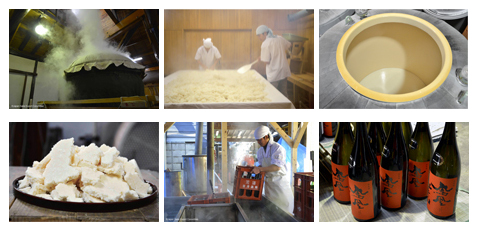JAPANESE SAKE
What is Sake?
Sake is an alcoholic beverage of Japanese origins that is made from rice. There are two basic types of sake, Futsu-shu(ordinary sake) and Tokutei meisho-shu(specially designated sake). Specially designated sake is distinguished by the degree to which the rice is polished and the absence of additions such as distilled alcohol.
Specially designated sake and their specifications

Sake grade levels are determined by the percentage of the rice that is polished before the brewing process In general, more the rice is polished, the higher grade sake is, and also more labor intensive and time consuming.
Main ingredients for sake brewing
1) Rice
Rice used for brewing sake is called Shuzo-kotekimai(sake rice). The grain is larger, stronger, and contains less protein and fat than the ordinary tables rice eaten. There are at least 90 types of sake rice in Japan. Among these, Yamadanishiki, Gohyakumangoku, Miyamanishiki and Omachi rice are very popular
2) Water
Water is one of the important ingredients for sake brewing. The brewing water is called Shikomi-mizu and involves in almost every major process of sake brewing.
3) Koji
Koji is steamed white rice onto which a mold, called Koji-kin(Koji mold) has been cultivated. Koji chop up the starch in the rice to provide the food(sugar) for the yeast cells.
4) Yeast
Yeast converts sugar to alcohol and carbon dioxide in the process for sake brewing. Without yeast, there is no sake. Yeast also influences many elements of sake taste, especially fragrance and flavor.
Sake brewing process
There are more than 1200 breweries in Japan. Each brewery uses different rice, yeast, koji and water in their own unique brewing methods. Sake brewing processes are very different from one brewery to another.

1) Rice polishing
The outer layers of unpolished rice contain a lot of fats, minerals and proteins that spoil the flavor of sake, therefore the rice is polished by using the rice polishing machine, known as Seimaiki.
▼
2) Washing and steaming
The polished rice is washed to remove the bran and is let steep in water. This is very important process that influences the rice after steamed. Then the rice is steamed.
▼
3) Koji production
For brewing sake, koji acts as enzymes to change the starch in the rice into sugar. Koji is made by cultivating koji mold on steamed rice.
▼
4) Yeast and seed mash
Before the main fermentation, seed mash, called Shubo is prepared by significantly increasing the amount of yeast in a small tank. In general, the size of Shubo is 1/10 of the main fermentation.
▼
5) Main mash
After Shubo is moved to a larger tank, more koji, more water and more steamed rice are added in 3 steps over 4 days. This method is called Sandan shikomi(3 steps method).
▼
6) Fermentation
Now main mash is ready for the fermentation. A day one as Moromi. In the Moromi, the enzymes in koji dissolve the steamed rice and the yeast ferment the resulting sugars simultaneously. Rice is melted by fermentation and it becomes more fluid like with each day.
▼
7) Pressing
When the fermentation is complete and reaches the target, Moromi is filtered and undissolved rice and yeast is removed, leaving the new sake. The lees left over from this process are called Sake-kasu. Sake-kasu is highly nutritious and many people use it for cooking.
▼
8) Sedimentation
After pressing, some turbidity remains. Sake is left in the tank as it is for a while in order to let them precipitate and the clear part is transferred to another tank.
▼
9) Filtering and adjustment
Filtering means to remove minute lees and organisms still remaining in fresh sake after sedimentation. New sake has alcohol content of 17% to 18%. The brewers often add water to slightly reduce the alcohol level by 1% to 2%
▼
10) Bottling and pasteurization
After sedimentation and adjustment, the sake is bottled and undergoes pasteurization. This process stops yeast and enzyme action, and kill off spoiling bacteria.
▼
11) Maturing and shipping
Under temperature control, sake ages for a month to a year. The brewers age sake in a variety of ways, some age at very low temperature in refrigerator, some at cool place inside of the brewery. After enough maturing, sake is shipped to the customers.
